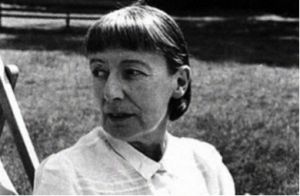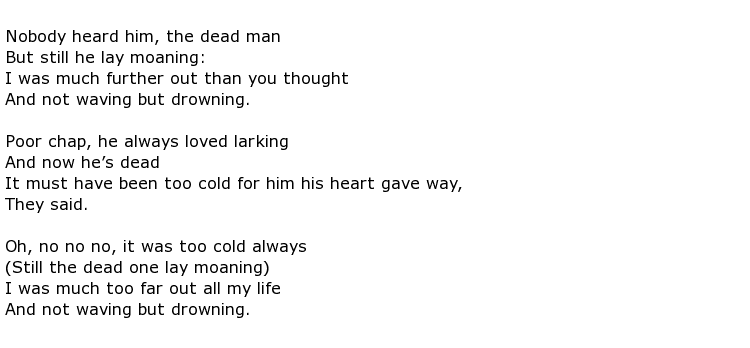 Stevie Smith was one of England’s best loved poets throughout the 20th century and one critic declared that her collection Not Waving, But Drowning, which came out in 1957, was actually the best to appear that year. She had a unique style that had a lot to do with never reading the work of her contemporaries. She enjoyed the older stuff like Tennyson and Browning but felt that the best way to keep sharp and original was not to read anything modern in case it accidentally influenced her writing. Her work was, most certainly, original but was often bordering on the morbid and depressing. One of her recurring themes was death, which she referred to as her “gentle friend”.
Stevie Smith was one of England’s best loved poets throughout the 20th century and one critic declared that her collection Not Waving, But Drowning, which came out in 1957, was actually the best to appear that year. She had a unique style that had a lot to do with never reading the work of her contemporaries. She enjoyed the older stuff like Tennyson and Browning but felt that the best way to keep sharp and original was not to read anything modern in case it accidentally influenced her writing. Her work was, most certainly, original but was often bordering on the morbid and depressing. One of her recurring themes was death, which she referred to as her “gentle friend”.
She was born Florence Margaret Smith in 1902 in the East Yorkshire coastal town of Kingston upon Hull. Her father left home when she was quite young to join the North Sea Patrol and never really came back. At home she was called by the shortened version of her middle name – “Peggy” – but somehow got renamed “Stevie” as a young woman. The story goes that a friend saw her riding a horse and likened her to the jockey Steve Donaghue, so it was Stevie from then on.
This was in London because, at the age of 3, her mother moved the family to Palmers Green. Stevie was virtually orphaned while still in her teen years. Her father was no longer on the scene and her mother died so Stevie and her sister became wards of an unmarried aunt who lived close by. This aunt became very important as Stevie’s life progressed and she was affectionately known as “The Lion”.
While in her twenties Stevie began to write poetry. She was working as a private secretary at a magazine publishing company and found the time to write her first novel which was published in 1936 – Novel on Yellow Paper. It was a serious piece of work focusing on the home front during WW1. She followed this with her first collection of poems in 1937 which was illustrated with doodles and rough sketches – a trait that she was to repeat often. A Good Time Was Had By All was an interesting collection which is recognised now as typically “Stevie Smith style”, with serious themes portrayed in a nursery rhyme structure.
She was a big fan of the Brothers Grimm fairytales and it seems that she was inspired in her poetry, to some degree, by these stories along with her somewhat volatile relationship with religion in general, and the Church of England in particular. She wrote, often in a playful meter with irony never far away. Take, for example, the title poem from the 1957 collection mentioned above. Not Waving, But Drowning is probably her best known poem and is a sad piece on how easy we misinterpret people’s struggles in their everyday lives. The poem tells us how easy it is to see one thing when the reality is quite different. Here is the poem:

This was pretty much a reflection of how Stevie Smith saw her own life. Always too far out, always struggling and death was never too far away. Her “gentle friend” claimed her in 1971 when she died of a brain tumour aged 69.

